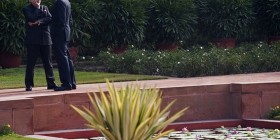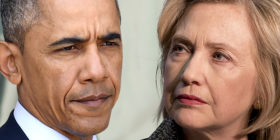Although Japanese leaders have visited Pearl Harbor before, Abe will be the first to visit the memorial that now rests on the hallowed waters above the sunken USS Arizona
Putting 75 years of resentment behind them, the leaders of the United States and Japan are coming together at Pearl Harbor for a historic pilgrimage to the site where the bloodshed of the surprise attacks drew America into World War II.
Prime Minister Shinzo Abe’s visit on with President Barack Obama is powerful proof that the former enemies have transcended the recriminatory impulses that weighed down relations after the war, Japan’s government has said.
For Obama, it’s likely the last time he will meet with a foreign leader as president, White House aides said. It’s a bookend of sorts for the president, who nearly eight years ago invited Abe’s predecessor to be the first leader that Obama hosted at the White House.
For Abe, it’s an act of symbolic reciprocity, coming six months after Obama became the first sitting US president to visit Hiroshima in Japan, where the US dropped an atomic bomb in hopes of ending the war.
“This visit, and the president’s visit to Hiroshima earlier this year, would not have been possible eight years ago,” said Daniel Kritenbrink, Obama’s top Asia adviser in the White House.
“That we are here today is the result of years of efforts at all levels of our government and societies, which has allowed us to jointly and directly deal with even the most sensitive aspects of our shared history.” More than 2,300 Americans died on December 7, 1941, when more than 300 Japanese fighter planes and bombers attacked.
More than 1,000 others were wounded. In the ensuing years, the US incarcerated roughly 120,000 Japanese-Americans in internment camps before dropping atomic bombs in 1945 that killed some 140,000 people in Hiroshima and 70,000 in Nagasaki.
Abe will not apologise for Pearl Harb or, his government has said. Nor did Obama apologize at Hiroshima in May, a visit that he and Abe used to emphasize their elusive aspirations for a nuclear-free future.
No apology needed, said 96-year-old Alfred Rodrigues, a US Navy veteran who survived what President Franklin D.
Roosevelt called a “date which will live in infamy.” “War is war,” Rodrigues said as he looked at old photos of his military service. “They were doing what they were supposed to do, and we were doing what we were supposed to do.”
After a formal meeting in the morning, Obama and Abe planned to lay a wreath aboard the USS Arizona Memorial, which is accessible only by boat. Then they’ll go to nearby Joint Base Pearl Harbor-Hickam, where both leaders will speak.
Obama and Abe signed off on the visit last month when they met in Peru on the sidelines of an economic summit.
Though the parallels with Obama’s Hiroshima visit are palpable, both governments said that one visit wasn’t contingent on the other.






Leave a reply